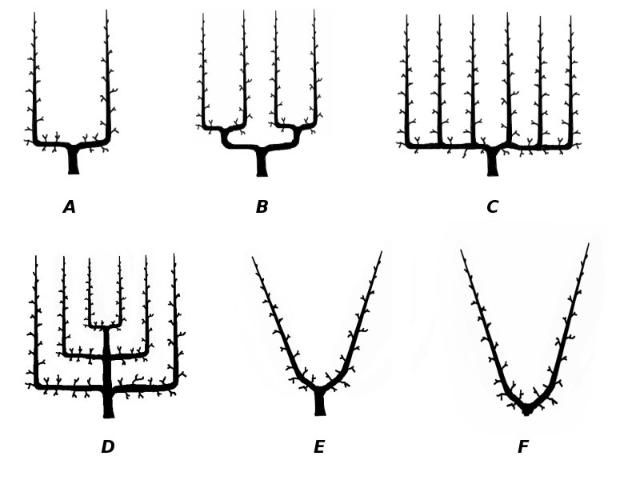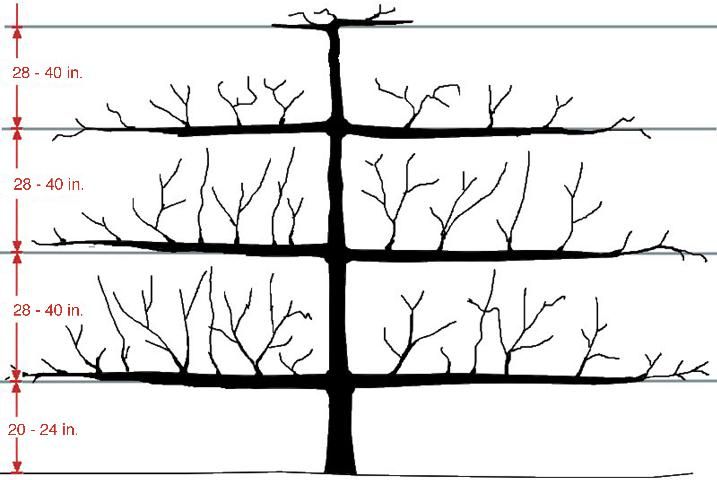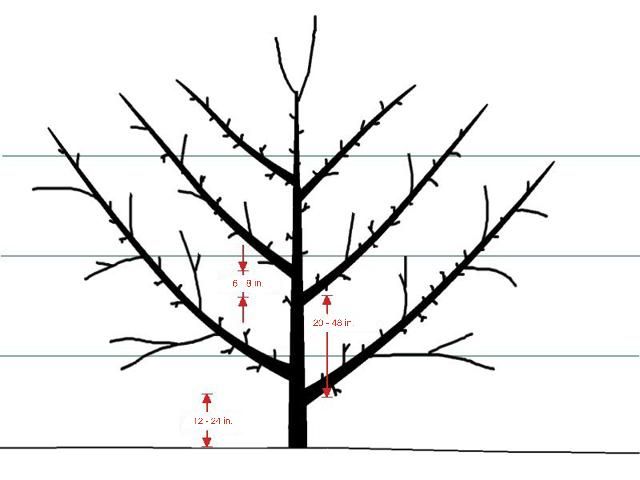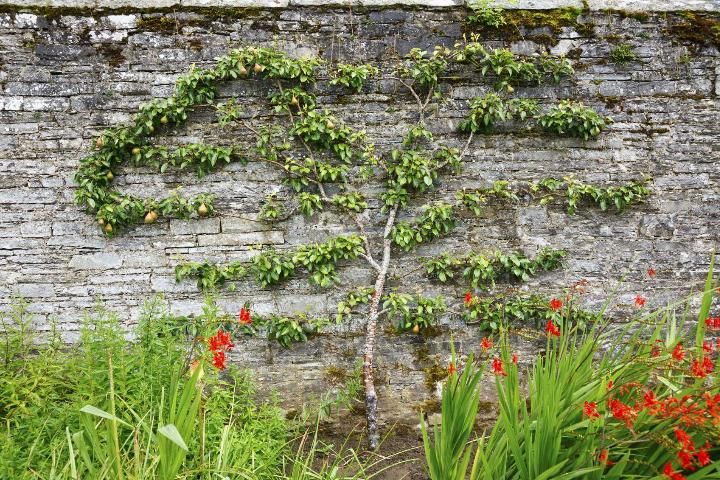
Credit: © 2004 Matthew Trump, CC BY-SA 3.0
An "espalier," (pronounced "es-PAL-yer" or "es-pal-YAY") is any plant trained to grow in a flat plane against a wall, fence, or trellis. The word espalier also may be used to describe the technique of training a plant to this flat plane. The Romans originated the technique, but later generations of Europeans refined it into an exacting but rewarding art.
The espalier has considerable merit in today's garden. The practice originally was used in the old world to conserve space. The English located espaliered fruit trees against a wall with a southern exposure for cold protection. Today, espaliers are used mostly for decorative accents in the landscape.
An espalier is a living sculpture in the garden and is especially effective against a blank wall as an alternative to a monotonous row of shrubs. An espalier is also a good choice for a narrow area where spreading shrubs or trees cannot be easily maintained. With landscape spaces becoming smaller around homes, an espaliered plant may have considerable appeal.
From Ornamentals to Espaliers
Almost any plant can be espaliered by continually directing growth along a flat plane and removing growth in undesired directions. Some plants are particularly suitable as espaliers, especially ones that produce many flexible lateral branches and attractive flowers, fruit, foliage, and/or bark. The plants listed in Tables 1–3 are only suggestions and are not intended to be inclusive. Other plants are worth trying and may prove to be equal to, if not better than, those listed.
Selecting an Espalier Pattern
The choice of a pattern for an espalier greatly influences plant selection and maintenance. Many plant species are suited for informal or free-form patterns, but only a few are suited to formal, symmetrical shapes. Tables 1, 2, and 3 suggest plants suited for formal patterns. Before purchasing a plant, make a sketch of your espalier pattern and ask a knowledgeable nursery professionals, a horticulturist, or your local UF/IFAS Extension office for help in selecting a plant that can be trained to this pattern.
Training an espalier can require many hours of maintenance. Pre-trained espaliers are available in the nursery trade and make it easier and faster for the average gardener to have an elaborate espalier. The formal patterns illustrated below in Figure 2 are for those people who like to clip and prune.
Formal Patterns

Credit: Giancarlo Dessi (CC BY-SA 3.0)

Credit: Giancarlo Dessi (CC BY-SA 3.0)

Credit: Giancarlo Dessi (CC BY-SA 3.0)
Informal Patterns
There are no rigid patterns to follow when developing an informal espalier. Plants can be allowed to grow into their natural shapes or they can be trained into free-form designs limited only by imagination and pruning skills (Figure 5). Informal espaliers usually do not require the kind of framework given to formal patterns; however, most need some means of support, at least until they are established.

Credit: Dmitry Naumov/istockphoto.com
Supporting Espaliers
Formal espaliers usually need a trellis or some other framework for support. The framework also provides a guide for training branches and serves to create the illusion of a complete espalier long before a plant is trained to a particular pattern. Wooden trellises should be constructed of rot-resistant woods such as cypress, cedar, redwood, or pressure-treated lumber. The support framework should be placed next to a wall or fence before installing the plant to be espaliered. When an espalier serves as a screen, construct a free-standing support framework consisting of sturdy terminal posts with wires stretched taut between them. Informal espaliers usually do not require the kind of framework given to formal patterns; however, most need some means of support, at least until they are established.
When espaliers are grown against a wall without a supporting framework, it is advisable to keep the plant 6 to 8 inches (15.2 to 20.3 cm) from the wall. This is particularly important on wooden walls where good air circulation helps prevent mildew, staining, and decaying of wooden siding. The space also facilitates training (tying, pruning, etc.), spraying for pests, and maintenance of the building (painting). Finally, leaving space creates interesting shadow patterns that add depth and interest to the espalier. Eye bolts may be used to attach a plant 6 to 8 inches (15.2 to 20.3 cm) from a wall.
Attach plants directly to masonry walls with anchoring devices such as masonry staples or concrete nails. Zinc or plastic anchors may be placed in mortared joints between concrete blocks or bricks and eye screws inserted. You may also glue vine ties (small discs with a short wire embedded) to masonry or wooden walls. These discs are easy to install but are suitable only for small specimens and are not as permanent as devices anchored in a wall. If vine ties are used, the ties should be loosened periodically to prevent the wire from girdling a branch.
Planting and Training Espaliers
Once you have selected a plant, pattern, and support framework, the next step is plant installation. Plants to be espaliered should be planted 6 to 8 inches (15.2 to 20.3 cm) from the wall or support framework in well-drained soil. Often, the soil at the base of a wall contains building debris such as concrete or stucco which should be removed and replaced with a better soil containing organic matter such as peat, compost, or manure.
Dig a hole one foot (30.4 cm) wider than the root ball of the plant. Backfill the hole with enough soil so that the plant sits in the hole with top of the root ball level with the top of the hole. Firm the soil in the bottom of the hole to prevent settling. Gently place the plant straight in the hole and fill around the roots with soil. Water thoroughly while planting to remove air pockets. Apply a 2- to 3-inch organic mulch to conserve moisture and help to control weeds.
The training technique used will depend on the pattern selected and the number of laterals on the plant. If you are following a design, carefully bend the branches into the desired positions and tie them into place. Remove all unwanted laterals or branches. If a design with a dominant main shoot is used, do not cut the top of the main shoot until the desired height is reached. A design with pronounced lateral growth requires that the terminal be cut at the level of the first branching, usually 15 to 18 inches (0.4 to 0.5 m) from the ground.
To maintain an espalier, prune and tie new shoots to conform to the desired pattern. Prune all stray branches that grow outward at right angles to the flat surface and those that grow beyond the boundaries of the desired pattern. Be careful to prune flowering shrubs and trees during the proper season.